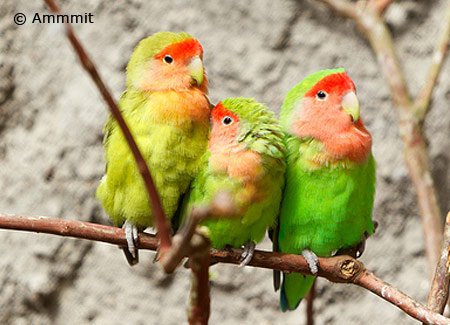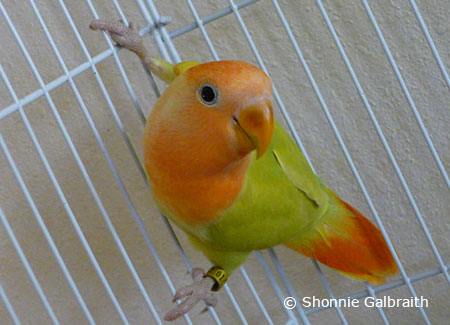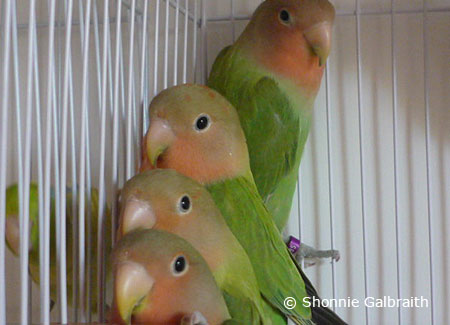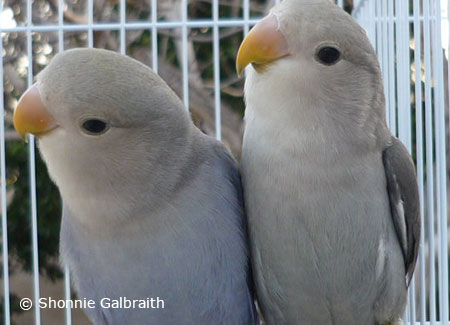Peach-faced Lovebirds
Common Names:
Peach-face Lovebird, Peach-faced Lovebird, and
Rosy-faced Lovebird
Scientific Name:
Agapornis roseicollis
Origin: Namibia,
Angola
Relative Size: 5 1/2
inches
Weight: 55-60 grams
Average Lifespan:
10-20 years
Egg Clutch: 2-6 eggs
Incubation: 23 days
Talking Ability:
Poor

General Information about Peach-faced Lovebirds
A normal Peach Faced Lovebird is green and has a red mask
that starts at the top of the forehead and fades to a peach color as it
moves toward the breast and neck area. The eyes are black with a thin
white circle around the eye. The beak is beige and extends downward
about an inch. The tail is multicolored with hues of blue, red, and
green. Peach Faced Lovebirds are the second largest of the lovebird
species; the largest being the Abyssinian Lovebirds.
Due to Peach Faced Lovebirds being kept more than other lovebird
species, many mutations have been bred and are available today in the
pet trade. The most common are the lutino, orange faces, opalines,
pieds, cinnamons, and creaminos.
Peach Faced Lovebirds in the Wild
These parrots are native to Africa and can be seen is flocks of fifty
or so. During the breeding season, the birds will branch off into
couples and find a small cavity to raise their babies. They thrive in
dry arid environments; however, these birds prefer to nest during the
rainy season as the embryos need a bit more moisture to develop and
hatch. In the wild, it is not uncommon to see these lovebirds feed on
blossoms or millet.
Currently, a documented population of Peach Faced Lovebirds has been
recorded in Phoenix, Arizona. They are able to survive through feeding
stations and fruit trees in urban areas. These feral lovebirds will nest
in old woodpecker cavities and especially those found in cacti.
Peach Faced Lovebirds in Captivity
Peach Faced Lovebirds have been in captivity for hundreds of years. It was not until they were imported and studied in the 1930’s did they become household pets. They were easy to breed and many breeders had established large colonies. As more mutations became available and pet owners discover these wonderful delightful parrots, they are quickly becoming even more popular as household pets. Because these parrots have become quickly accepted into general households, they have now become a rival to budgies and cockatiels. These are wonderful pets and are a joy to watch. It’s important to note that they can have a long life span if handled properly.
Peach Face Lovebirds as Pets

The Peach Faced Lovebird is the more common of the lovebird species
kept in captivity. They are easy to breed and make fantastic pets if
handfed or tamed. Many owners will spend countless hours with their
birds perched on their shoulders while watching television or reading a
book. It is important these birds be worked into the owner’s daily
activities as they crave human affection. If the parrot is tamed and has
bonded to their owner, most will continue to demand affection and enjoy
being petted on the back of their necks.
These birds are very loyal companions. They form monogamous bonds in the
wild and seem to practice the same behavior towards their owners. For
this reason, a new baby lovebird should be exposed to all family members
to avoid jealousy and biting. All family members should participate in
bird chores and reward the bird with treats.
The owner of the bird should use positive reinforcement to mold the
lovebird’s behavior as it matures. All negative behaviors should be
ignored (biting or screaming) and should only be praised and given
treats when it is acting as it should. A lovebird is very smart and will
change its behavior as soon as it starts to understand its boundaries.
Because of their curiosity, these birds are very playful and need toys
to occupy them while their owners are away. Not only do toys occupy the
lovebird, but it teaches the bird how to act independently when the
owner cannot spend time with the parrot. Special toys with bright
colors, various types of beads, and small wood blocks should be placed
into the cage. This allows the bird to chew and play. These birds also
enjoy ropes to hang from and appreciate paper towel rolls to quickly
chew at them.
It is important a pet lovebird not have a nesting box placed into the
cage as this will cause the lovebird to become territorial, thus leading
to many behavioral problems.

Peach Faced Lovebirds are not great at talking. Although, those that do talk tend to be females. These birds have higher pitched sounds and some have described their voices as sounding like a whistle with consonants. If the owner wishes to train their parrot to talk, they need to continue repeating words daily in an excited high pitched voice. Avoid using old tape recorders that repeat phrases as this will bore the parrot.
Peach Face Lovebird Breeding
Peach Face Lovebirds can breed year round but should not be allowed
to breed during hot summer months. High heat can kill young chicks and
create an uncomfortable environment for both the hen and her babies. As
the breeding season approaches, the female lovebird will tuck nesting
material into her wings and will carry it back to the nest. During this
time, males will mate with the female repeatedly and eggs can be
expected within three to five days after mating. The females will
usually start to incubate once two eggs are laid. The clutch can consist
of two to six eggs and incubation lasts 23 days.
Lovebirds need a higher amount of humidity for proper hatching. Females
will often bathe daily to supply an ample amount of moisture for her
clutch of eggs. Spraying outside the nesting box with a spray bottle
will greatly increase a proper hatch--this can be done twice a week.
Another idea for more humidity is giving the birds green grasses or palm
leaves which are then shredded by the birds. This helps to greatly
enhance moisture inside the nest. Spraying inside the nest box with a
spray bottle should never be done as it can kill the developing
embryos—just a few pumps of water outside the box will do the trick.
Lovebirds can breed twice a year; however, it’s highly recommended that
the pair be given a season to rest. A female will willingly produce four
clutches a year if given the chance. This type of breeding is unethical
and will quickly result in an exhausted hen that will have a short
lifespan. Proper nutrition is a must for the growing chicks and hen to
maintain optimal health.
These small sized parrots are the more aggressive species of lovebirds
and can become territorial during breeding; especially the females.
Keeping a watchful eye on the birds can prevent injury or even death
during territorial disputes.
Because of their aggression, when breeding in colonies, adequate space
must be provided to ensure less tension. Placing extra food bowls around
the aviary will greatly help maintain the peace.
If babies are to be pulled for hand feeding, they should be pulled at
around eight to ten days old. It is a good idea to pull all the chicks
as pulling only one chick will cause the mother to abandon her nest.
Most lovebirds wean around 10 to 13 weeks but some can take longer. A
young Peach Face Lovebird will have black markings on its beak which
will fade as the baby matures.
When weaning, these parrots should be exposed to many different foods to
ensure the parrots do not become picky as they mature. Most owners will
place different fruits and vegetables inside the weaning tank as this
gives the parrots enough time to become accustomed to the textures and
tastes of different foods.
Finding the Right Cage for your Peach Faced Lovebird

A parakeet cage is not a good choice for a Peach Faced Lovebird.
Though these parrots are slightly larger than a budgie, they need enough
room to house their toys, perches, food and water bowls, and an all
important bath bowl.
The bars of the cages should not be too large, nothing over half an
inch, as the lovebird might get his head stuck between the bars.
It’s important the cage be powder coated or be made of stainless steel.
Galvanized or zinc made cages can cause metal toxicity and can easily
poison these parrots. Most cages can now be purchased or coated with a
non-toxic paint to cover the bars.
A perch should be placed in the center of the cage. It is important
there be other perches with different diameters so the parrot can
exercise its feet. The perches should also be placed away from food and
water bowls as the lovebird’s droppings will contaminate food and water
bowls. The bottom of the cage needs to have a grill installed. This
grill will act as a barrier between spoiled food and the bird’s
droppings.
The cage should have a door large enough so the owner can place both
hands into the cage. Most cages made for lovebirds have three doors and
this tends to work perfectly. It is important these doors have a lock
because Peach Faced Lovebirds will learn to escape from their cage.
Feeding Your Lovebird
These small parrots enjoy a variety of foods. Unlike most parrots
that manipulate their food with one hand, lovebirds cannot do this. For
this reason, their food should be shredded or chopped finely to ensure
that the lovebird can easily eat it.
Leafy greens should be given daily such as spinach, kale, or carrot
tops. Normal iceberg lettuce should be avoided as this has minimal
nutrients and might cause the lovebird to have diarrhea.
Other foods to feed are carrots, squashes, apples, oranges, or cooked
beans. It’s important the diet be varied as this allows the maximum
amount of nutrients to the parrot. All fresh food items should be
removed after a few hours to ensure it does not spoil.
Along with fresh fruits and vegetables, a base diet of seeds and pellets
also need to be provided. Some lovebirds will refuse to eat pellets but
the owner should gradually introduce them into the lovebird’s food. It
can take weeks or months to train the parrots to accept new foods. The
owner should be patient and consistent when converting their lovebird
over to new food
ideas. It is important not to replace seeds with just pellets because
most lovebirds will starve to death rather than eat the pellets. It
takes time to get a lovebird to get used to eating pellets.
If a Peach Faced Lovebird is fed a healthy diet, most can reach 10 years
or more and some can even reach 20 years.




